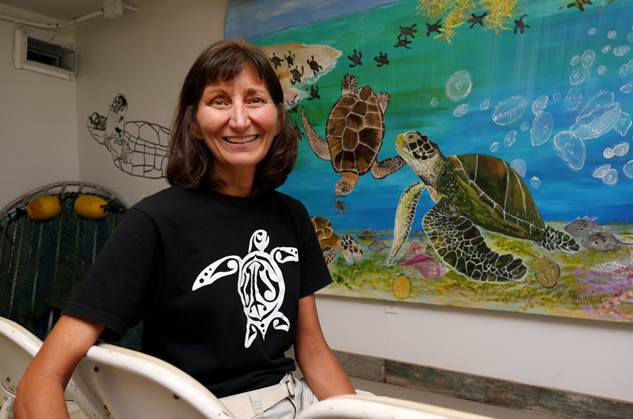Published page A1, The Daily News of Galveston County

Joanie Steinhaus Campaign Director for Turtle Island Restoration Network’ Gulf Office, hopes to build a sea turtle incubation facility in Galveston.
Sea Turtle eggs found in Galveston County and the upper Texas Coast are taken to Padre Island National Seashore where they are released once they hatch.
Monday, August 7, 2017–Each time Joanie Steinhaus and her team of monitors find a turtle nest on the upper Texas coast, they act fast.
The monitors create a sling, cushion the nest in a crate and carefully strap it in the back of a truck.
Then, volunteers drive the nest roughly 250 miles from Galveston to the Padre Island National Seashore near Corpus Christi, where eggs are incubated, hatched and released. With each bump in the road, the monitors fear the eggs could break, making them no longer viable, Steinhaus said.
Hatching and releasing the Kemp’s ridley turtles miles down the coast from their nests may also be shifting the population, local advocates said.
Steinhaus, the campaign director for Turtle Island Restoration Network, would rather not do all of that anymore.
“It’s a five to six hour drive,” Steinhaus said. “Not that these people are racing, but the potential for something to happen always exists, for the eggs to be damaged.” Instead, she’d like to have an incubation site on Galveston Island.
“Why should we be moving the eggs so far and taking the risk?” Steinhaus said. Steinhaus and her turtle monitors spend hours each day during the turtle nesting season searching from Surfside Beach to Bolivar Peninsula for Kemp’s ridley turtle nests. So far this season, which is from April to September, Steinhaus and others found 11 nests on the upper Texas coast. Volunteers transferred all of them to Padre Island National Seashore, she said.
Kemp’s ridleys, known as the world’s most endangered sea turtles, are found mostly in the Gulf of Mexico. As part of conservation efforts, environmentalists are intervening, fearing that turtle nests could be either tampered with on land or that newly hatched turtles couldn’t safely make it out to sea.
When volunteers find Kemp’s ridley nests, they take them to an incubation site, where the eggs are protected until they’re ready to hatch. When the hatchlings are ready, the newborn turtles are released and crawl across the beach, in pursuit of the sea.
Nest findings in Texas have reached an all-time high this year. At Padre Island National Seashore alone, 218 nests were recovered. In Texas, 352 total nests were found, according to preliminary numbers from the National Park Service.
But Steinhaus and several other area environmentalists are concerned about what this means for the turtles in the upper Texas coast. When hatchlings are released, they tend to make their way back to the release site as adults to nest eggs, said Carole Allen, founder of Help Endangered Animals — Ridley Turtles.
“If you keep moving these eggs, eventually the ones that are released from Padre Island are going to go back there to lay eggs,” Allen said. “If we can incubate them here and then release, that population will grow just like it did at the National Seashore. Then you’ve got the turtles down there and the turtles up here.”
Still, creating a turtle incubation site on Galveston Island won’t be easy, Steinhaus and others say. Environmentalists here would have to find a place to build a corral and then go through a lengthy permitting process, Steinhaus said.
Chuck Underwood, spokesman for the Fish and Wildlife Services North Florida office, said creating a corral is possible, but definitely difficult.
“It can be somewhat costly and a time-consuming process,” Underwood said.
Donna Shaver, chief of the Division of Sea Turtle Science and Recovery at the National Park Service, also said creating an incubation facility in Galveston could be difficult. “This is much more complicated than someone having something they’d like to do,” Shaver said. “There’s permitting involved and many other things.”
But Steinhaus and others have already gotten the ball rolling. She went to South Padre Island to train in hatchling releases and has set up numerous meetings with federal agency officials about the project.
Steinhaus is considering the Galveston Island State Park for a possible corral site, she said.
If the federal agencies determine that Steinhaus can create a new corral, the state park would be happy to participate, said Hans Haglund, park superintendent at the Texas Parks and Wildlife Department.
“It’s not something that we ourselves have a lot of control over,” Haglund said. “Being a listed endangered species, there’s a lot of folks in charge of the recovery of those.”
But, if officials in charge of recovery efforts give the green light, then Haglund’s group would be willing to work with those in charge of it, he said.
Steinhaus and her colleagues in the area are working to get the conversation started, she said.
“I feel like we are really doing our homework, really looking at the data,” Steinhaus said. “There is absolutely no reason why it shouldn’t be an open conversation. We realize this is a process, and our hope is to do what’s best for the turtles.”






